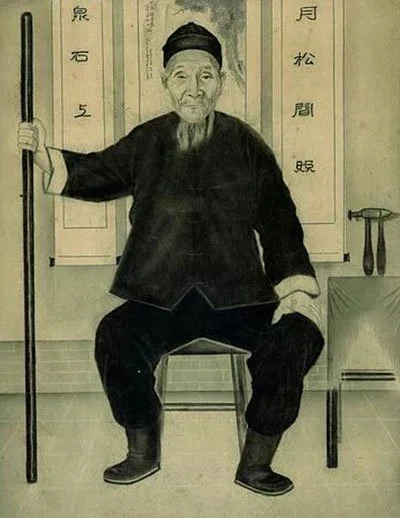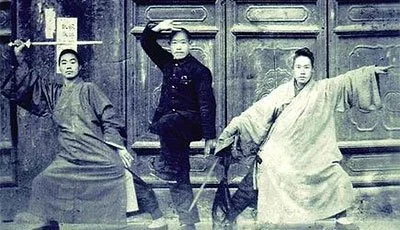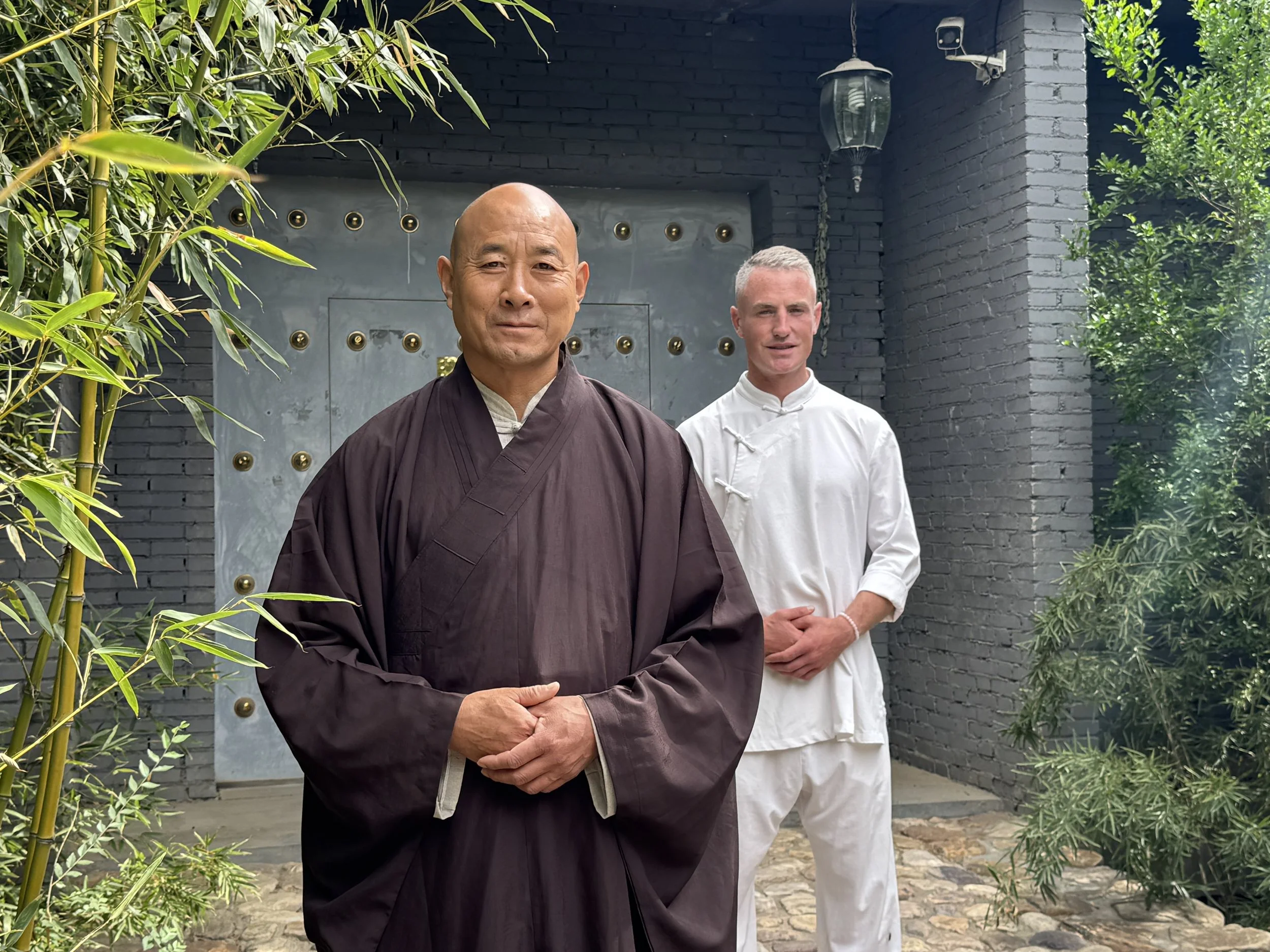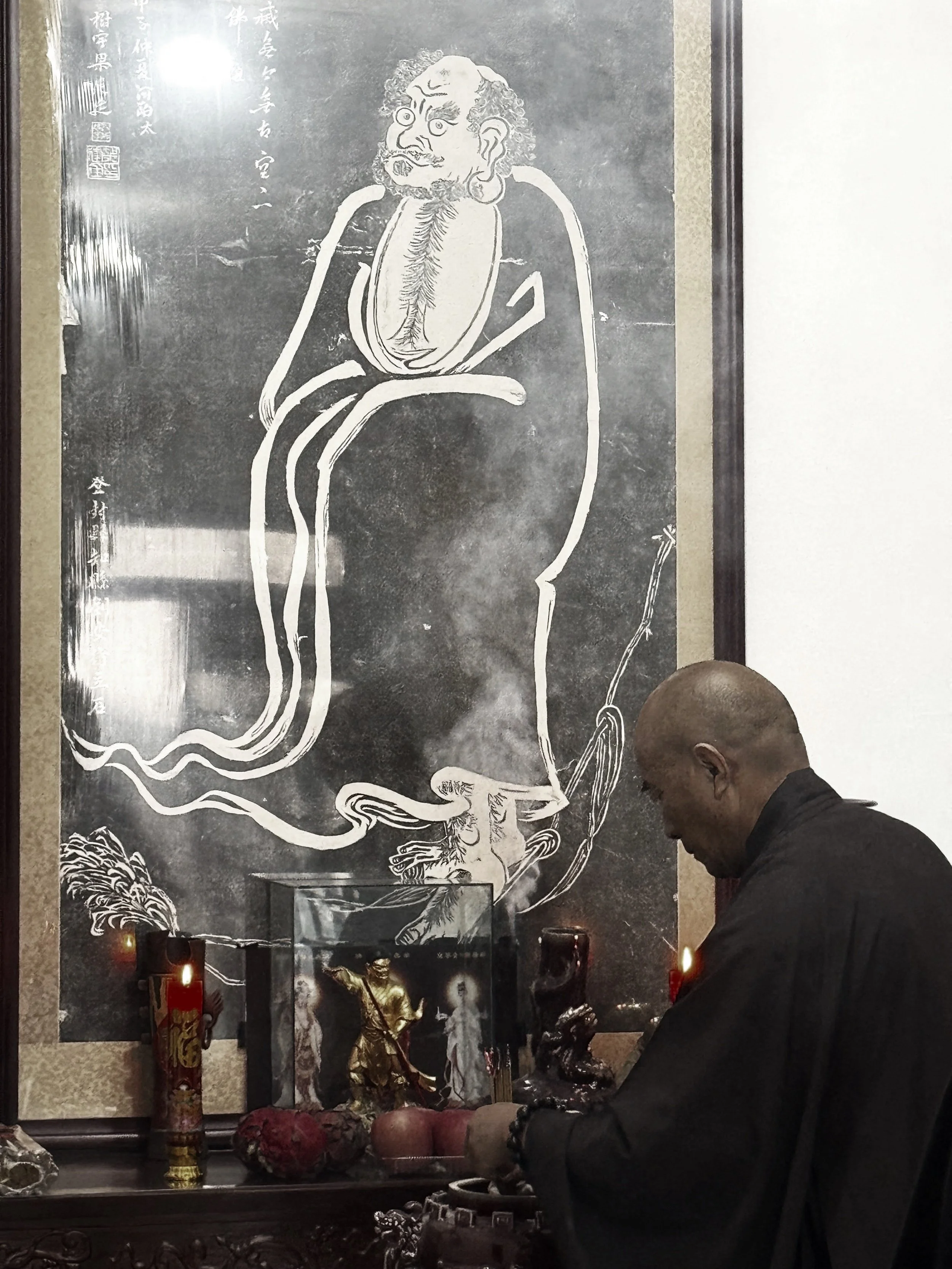The Lineage
From Bodhidharma to Shifu Wu Nanfang
1500 years ago, Bodhidharma arrived at Shaolin Temple and found a problem.
The monks were lost in ritual and study. They pursued enlightenment through texts and ceremonies, caught in intellectual understanding and superficial practices. Their minds were cluttered, their bodies weak.
So Bodhidharma taught them to sit facing a wall in true meditation—cutting through mental noise to find genuine stillness. He also introduced systematic physical exercises to strengthen their bodies and unite physical practice with spiritual cultivation.
But his deepest gift was the essence of Zen itself: direct transmission from mind to mind, beyond words and scriptures. Born from the stillness of deep meditation, this wordless understanding passes between master and student in a moment of recognition. Anyone with genuine sensitivity can feel this transmission—it's what distinguishes authentic Zen from mere philosophy.
This is what we preserve.
Every full moon and new moon, we gather before Bodhidharma's statue in our temple. We honour not just the historical figure, but the unbroken chain of transmission he began—that wordless understanding passed from teacher to student for fifteen centuries.
Bodhidharma showed that Zen lives in movement as much as in stillness. That the body itself is the temple. That physical practice, correctly undertaken, becomes meditation.
This planted the seed of Chan Wu—Zen martial arts. Not fighting techniques or performance art, but Zen expressed through the body.
For a thousand years, this understanding developed within Shaolin's walls. Monks discovered that martial practice wasn't separate from spiritual cultivation—it was another door to the same realisation.
Chan Master Sengchou, Shaolin's second abbot, embodied this fusion. Texts describe him as "swift and courageous, with a light and agile body".
The tradition crystallised during the Ming Dynasty under Master Wuyan Zhengdao (1592-1609). He systematised the complete Chan Wu transmission, establishing Yonghua Hall in Shaolin's southern courtyard. There he wove together:
Chan (Zen meditation and philosophy)
Wu (martial arts as spiritual practice)
Yi (medicine and healing)
Fourteen generations carried this system forward within Yonghua Hall. When the Qing Dynasty banned martial arts, the transmission went underground through Master Zhanmo at remote Shigou Temple.
In 1836, a five-year-old boy arrived at that temple.
Wu Gulun: Founder (1831-1914)
Wu Gulun came from poverty. His family sent him to Shaolin Temple for monastic life, but fate intervened. Instead of joining the general monks, he was taken directly to Master Zhanmo, keeper of Shaolin's deepest teachings. He received the Dharma name Jiqin.
The times were dangerous. The Qing ban on martial arts had lasted over a century. Monks practised in secret, training at night in the Thousand Buddha Hall where forty-eight depressions worn by generations of feet remain visible today.
Wu Gulun excelled quickly. When he sought to learn Shaolin's supreme Chan Wu heart methods, Zhanmo repeatedly refused. So the young monk studied in secret for three years until Zhanmo summoned him: "Show me what you've learned."
This was the test—not of skill but of determination. Zhanmo had known all along. Satisfied with his student's hunger for knowledge, he transmitted the complete teachings. Wu Gulun became the 15th generation successor of Yonghua Hall.
The temple monks called him "White Tiger Star" for his abilities. Stories spread of crushing stones to powder, crossing rivers without wetting his shoes. For those who understand internal energy, these represent the natural outcome of unified mind, qi, and body.
In 1869, with China in chaos and Shaolin under threat, the temple leaders made a desperate decision. They chose Wu Gulun—their most accomplished master—and gave him an unprecedented mission: Leave the temple. Return to lay life. Marry. Have children. Preserve the teachings until China was ready for their return.
Before departing, Wu Gulun passed the "Mountain Gate Test," proving mastery of Shaolin's complete system. He became the last monk ever to pass this examination.
Wu Gulun settled in Tangzhuang, married, and practised medicine. But word spread about the former monk carrying Shaolin's secrets. After his pregnant wife miscarried during a confrontation with challengers, he moved his family to remote Yangshumiao Village.
There he transformed Shaolin's temple practices into a system that could be cultivated through daily life. Farming became training. Medicine became philosophy. Every action held potential for realisation.
Wu Shanlin: The Revitaliser (1875-1970)
Wu Gulun's second son inherited both techniques and understanding. From childhood, Wu Shanlin farmed, studied medicine, and practised alongside his father. Through decades of integrated practice, he discovered that true mastery doesn't require temple walls.
He became the first to teach Gulun Kung Fu openly outside the family. His reputation spread as a healer—locals called him "Master of Massage."
Then came 1928. Warlord Shi Yousan burned Shaolin Temple. Eighteen buildings destroyed. Thousands of texts lost. The monks scattered.
In 1931, surviving abbots invited Wu Shanlin—a layman—to resurrect Shaolin's martial arts. He trained over forty warrior monks, including future masters De Gen and Xing Zhang. Many who later claimed fame through "Shaolin Kung Fu" traced their lineage through him.
At age 88, when Wu Shanlin demonstrated the supreme Xin Yi Ba form, officials from the National Sports Commission declared: "His skills are consummate."
Through war and revolution, Wu Shanlin kept the transmission alive. Not in a temple, but in a farmhouse. Before dying at 95, he passed everything to his descendants with one instruction: Wait until the world is ready to understand that Chan Wu isn't about fighting—it's about transformation.
The Warriors: Wu Tianyou (1898-1950) and Wu Musheng (1930-2013)
Wu Tianyou (1898-1950) was Wu Shanlin's eldest son and designated successor. From early childhood, his father trained him intensively in all aspects of Gulun Kung Fu—not just the physical techniques but the philosophical understanding and medical knowledge that made the system complete.
By his twenties, Wu Tianyou was teaching neighbours and local students. In 1931, he accompanied his father to Shaolin Temple to help resurrect the martial arts programme. In 1937, at the invitation of local authorities, he established his own school at Zhongyue Temple, teaching monks, Taoists, and laypeople alike.
When Japan invaded, Wu Tianyou didn't retreat into contemplation. He founded resistance training camps and led a broadsword unit through enemy blockades. During one operation near Zhitan, he was shot close to the heart. He survived but the wound never fully healed.
Understanding his time was limited, Wu Tianyou intensified the training of his second son, Wu Musheng, passing on not just forms but the essence of the practice. He emphasised that Gulun Kung Fu served life—defending family, community, and nation when necessary, but always rooted in spiritual cultivation.
When the Korean War began in 1950, Wu Tianyou made a fateful decision. He sent Wu Musheng to serve, knowing his son carried the complete transmission and could continue the lineage. A month after Wu Musheng departed, the old wound reopened. Wu Tianyou died, having ensured the teachings would survive.
Wu Musheng (1930-2013) had trained under both his father and great-uncle Wu Youde from age five. By twenty, he'd mastered the complete system. His military service as a platoon leader in Korea earned him numerous honours. The North Korean government, recognising his extraordinary abilities, offered him a prestigious position and wealth to remain and establish a martial arts programme.
But Wu Musheng understood his true responsibility. He returned to China, to the family compound in Yangshumiao Village. For the next sixty years, he refined and preserved the teachings. He never married, dedicating every moment to maintaining the purity of the transmission.
In his later years, Wu Musheng recognised that his brother Wu Gensheng's son, Wu Nanfang, possessed the qualities necessary to carry the lineage forward. He took the boy as his primary disciple, training him with the same intensity his own father had shown, ensuring every detail of the tradition passed intact to the fifth generation.
Wu Youde: The Hidden Teacher (1908-1980)
While others fought wars, Wu Youde maintained the internal transmission. Wu Shanlin's second son possessed a different temperament than his brother—quieter, more introspective, but equally dedicated.
He taught select students and security forces, but his primary focus was preparing the next generation. When his great-nephew Wu Nanfang showed exceptional promise, Wu Youde took personal responsibility for his early training, laying the foundation that Wu Musheng would later build upon.
One night in 1975, two robbers ambushed the seventy-year-old master. In seconds, both lay unconscious. Wu Youde had barely moved. This is Xin Yi Ba—where intention, energy, and action merge spontaneously.
Wu Nanfang: The Fifth Generation Master
Wu Nanfang was born in 1962, when great-grandfather Wu Shanlin was 88. The elder recognised something in the child.
As a boy, Wu Nanfang slept beside his great-grandfather, absorbing presence as much as stories. Days were spent watching every movement, witnessing Chan Wu in every gesture.
The elders took him to Shaolin Temple's Baiyi Hall, where murals depicted ancestor Wu Gulun. Standing before these images, something awakened—not ambition, but destiny.
He studied under grandfather Wu Youde, uncle Wu Musheng, cousin Qiao Heibao. For over twenty years, he trained with Master Xingxing in both martial and Zen practices. In 1995, he took refuge with Venerable Shisu Xi, receiving the Dharma name Defang.
Wu Nanfang spent decades collecting scattered fragments of Gulun Kung Fu. Every lead followed, every source honoured.
"If I do not pass down this essence," he says, "I will die a sinner."
Shifu Wu Nanfang – Testament from Ben Lucas
I have had the privilege of training one-on-one with Shifu Wu Nanfang for ten months. Every day we practise, drink tea, and I observe a human being unlike any I've encountered.
In those ten months of daily contact, I have never once seen him irritated, nervous, or worried. He exists in constant inner harmony, with sunlight seeming to shine from within. At 63, he looks exactly as he did in videos from 15 years ago.
He embodies perfect yin-yang balance—extraordinarily powerful yet utterly peaceful. He can speak loudly and forcefully without a trace of aggression. His kindness makes everyone around him feel uplifted.
He lives simply and humbly, completely untouched by commercial pressures.
Everyone who meets him recognises immediately that he has touched something real. He is deeply spiritual without any pretentiousness. Nothing he teaches comes from books—everything emerges from his own direct experience. He teaches in his own words, his own understanding.
For him, the secular and spiritual are not separate. Kung fu exists everywhere in daily life. You never see rushing or imbalance in him. A true master.
It is his absolute sincerity and purity of purpose that inspired me to dedicate everything to preserving these teachings.
The Uniqueness
Shifu Wu Nanfang is one of the last living holders of authentic internal Shaolin kung fu. This ancient art exists only through his family's five-generation transmission. No other teachers. No other schools. Without successful transmission to the next generation, this lineage ends forever.
This shapes everything. Commercial considerations don't influence the teaching. Traditional methods continue unchanged. The practice remains exactly as Wu Gulun established it 150 years ago.
Students must understand: this isn't modernised kung fu. The training is traditional, demanding patience and dedication. But for those seeking authentic internal cultivation—the original fusion of Zen and martial arts that Bodhidharma began—this is the purest source available.
Master Wu Nanfang opens this door now, seeking sincere students to carry the transmission forward. The opportunity is rare. The responsibility is real.







